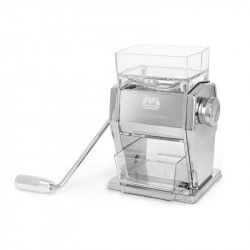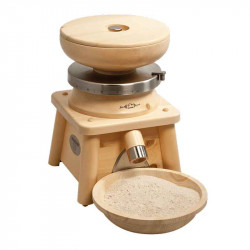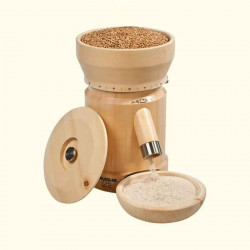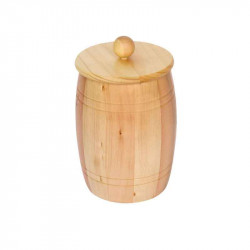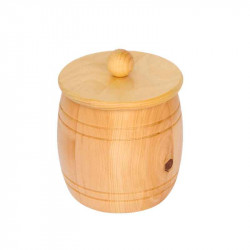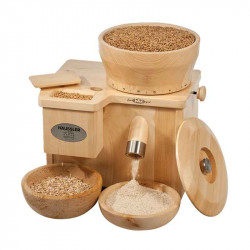Grain mills
What are the best grain mills?
There are many different types of grain mills on the market, each with their own advantages and disadvantages. Here are some of the best grain mills that are often recommended:
1. KoMo Grain Mills: KoMo is a well-known manufacturer of high-quality grain mills from Germany. They offer a wide range of models that are suitable for both home and professional use.
2nd Häussler grain mills. Häussler is a very famous German manufacturer and known for its exceptional quality.
3. marcato grain mills and flake crushers Marga Mulino. Is a well-known Italian manufacturer of pasta and grain mills.
4. Hawos Grain Mills: Hawos is another German manufacturer known for their high quality grain mills. They offer a good selection of models that can be operated both electrically and manually.
5. Mockmill Grain Mills: Mockmill grain mills have been developed in collaboration with Wolfgang Mock. They are characterized by their high quality and ease of use.
6. Schnitzer Grain Mills: Schnitzer offers a wide range of grain mills for different needs. They are known for their durability and precise grinding performance.
7. WonderMill Grain Mills: WonderMill is a US manufacturer known for its powerful electric grain mills. They are easy to use and can grind large amounts of grain quickly.
It is important to note that choosing the best grain mill depends heavily on individual needs and preferences. Care should be taken to ensure that the mill is suitable for the type of grain to be ground and that it produces the desired grind. It is also advisable to read reviews and testimonials from other customers to get an idea of the quality and performance of the grain mills.
How are grain mills operated nowadays?
Grain mills today are mainly powered by electricity. Electric motors drive the grinding stones that turn the grain into flour. However, there are still traditional mills driven by water power or wind power. However, these mills are used less frequently.
Where to get a flour mill?
You can buy a grain mill in various stores and online stores. Here are some options where you can get a grain mill:
- specialty stores for household goods or kitchen appliances: In such stores that specialize in kitchen supplies, you can often find grain mills. Here you can get advice from specialized staff and take a look at different models.
- Organic or health food stores: In organic and health food stores there is often a selection of household appliances for processing natural products. Here, too, you can ask about grain mills.
- Online stores: Platforms such as the specialized online store of miniSchoggi offer a large selection of grain mills of different brands and models. Here you can compare and order different offers from the comfort of your own home.
- Directly from the manufacturer: Many manufacturers of grain mills also offer their products directly via their own websites. Here you can often obtain detailed information on the technical details and order directly from the manufacturer.
- Flea markets or second-hand stores: With a little luck, you can also find a used grain mill at flea markets or second-hand stores. Here, however, you should make sure that it is in good condition and that all the necessary parts are present.
So there are various ways to get a grain mill. It is worthwhile to compare prices and offers and to inform yourself well about the different models before buying, in order to find the right model for your own needs.
What makes a grain mill so expensive?
A grain mill can be expensive for several reasons:
1. High quality of materials: A high quality grain mill is made of robust and durable material such as stainless steel or cast iron. This results in higher production costs.
2. Precision mechanics: An expensive grain mill has precise adjustment capabilities to fine-tune the grind of the grain. This requires sophisticated technology and precise engineering.
3. Powerful motor: An expensive grain mill often has a powerful motor that ensures consistent grinding even under heavy use.
4. Convenience and additional features: Some more expensive grain mills offer additional features such as automatic grinding programs or an integrated sieve to separate the ground material. These additional features increase the price.
5. Brand value: Some expensive grain mills are from well-known brands that are known for quality and durability. Brand value and the trust that comes with it can increase the price.
It is important to note that a more expensive grain mill is not necessarily better than a less expensive option. Price can also be influenced by brand reputation or intended use. It is worth comparing the different models and their features to find the right grain mill to meet your needs.
Where to buy grain mills online or in store?
Grain mills can be purchased online or in various stores. Here are some options:
1. Online retailers: Platforms such as miniSchoggi offer a large selection of grain mills of different brands and models.
2. Specialty stores for kitchen utensils: Stores often carry grain mills in their assortment.
3. Organic stores: Organic markets such as Alnatura or Denn's Biomarkt are often good places to start, as they offer a selection of natural or organic grain mills.
4.. farmers' markets: local farmers' markets or weekly markets may offer grain mills, especially from regional vendors who rely on traditional processing methods.
5. direct from the manufacturer: many manufacturers of grain mills have their own online stores through which products can be purchased directly. An internet search for the desired manufacturer can be helpful.
Before buying a grain mill, it is advisable to compare prices, reviews and product descriptions to make the right choice for your needs.
What are the best features to look for in a grain mill?
When buying a grain mill, you should ideally pay attention to the following features:
1. Grinding mechanism: The grinding mechanism should be made of high-quality materials such as stone or ceramic to enable fine and gentle grinding of the grain.
2. Grinding degree adjustment: The grain mill should have a continuously variable grinding degree adjustment to enable you to individually adjust the degree of fineness of the ground flour.
3.. motor power: Depending on the desired quantity and type of grain, a sufficiently powerful motor is important so that the mill can grind the grain efficiently and quickly.
4. Capacity: The capacity of the grain mill should be adapted to individual needs, depending on the desired quantity of grain and the frequency of use.
5. Robustness and durability: The grain mill should be made of robust materials to ensure a long service life. Solid workmanship and good quality components are also important to ensure a long service life.
6. Cleaning: Easy cleaning of the grain mill is also beneficial to easily remove residue from ground grain.
7. Safety: The grain mill should have good safety features, such as overheating protection or automatic shutdown in case of overload.
8. Operation: User-friendly operation and an easy-to-understand control panel or control buttons are beneficial to make the mill easy and straightforward to use.
9. Manufacturer and Customer Reviews: It can be helpful to find out about the manufacturer and its reputation, as well as customer reviews of the grain mill, to identify potential problems or weaknesses.
10. Value for money: The initial cost should be reasonably proportionate to the performance provided. You should make sure that you get excellent quality and function for the price. It can also be helpful to compare prices and offers from different manufacturers.
What all can be ground with a grain mill?
A grain mill can grind different types of grains, pulses and spices. These include:
- Wheat: wheat flour for bread, cakes, cookies, etc.
- Spelt: spelt flour for bread, pastries, pasta, etc.
- Rye: Rye flour for rye bread and rye dough
- Oats: oat flour for oatmeal, cereal, etc.
- Barley: barley flour for bread, soups, etc.
- Corn: corn flour for tortillas, corn bread, etc.
- Rice: rice flour for gluten-free baking, rice noodles, etc.
- Buckwheat: buckwheat flour for pancakes, noodles, etc.
- Chickpeas: chickpea flour for falafel, hummus, etc.
- Lentils: lentil flour for soups, pancakes, etc.
- Spices: e.g. pepper, cumin or coriander can also be ground.
It is important that the grain mill is suitable for the particular variety, as some grains are harder or oilier than others and require special grinders.
Is it possible to grind millet yourself?
Yes, it is possible to grind millet yourself. To do this, you need a grain mill or a coffee grinder with a grinding mechanism that is also suitable for grinding grain. The millet grains are filled into the mill and then ground into flour. The home-ground millet flour can be used to make bread, cakes or other baked goods.
Can you grind nuts with the mill?
Yes, you can use a grinder to grind nuts. Many mills are designed to grind different types of food, including nuts. However, it is important to note that not all grinders are suitable for grinding nuts. It is advisable to read the manufacturer's instructions and ensure that the mill is suitable for grinding nuts before attempting to do so.
Why make your own flour?
There are several reasons why you should make your own flour:
1. Freshness: Homemade flour is much fresher than store-bought flour because it is milled directly from the grains. This preserves the natural flavors and nutrients.
2. Control over quality: When you grind your own grain, you have full control over the quality of the flour. You can choose exactly the grain you want to use and make sure there are no additives or preservatives.
3. Individuality: Self-milling allows you to combine different types of grain to make your own individual flour. This opens up a wide range of possibilities for baking and cooking.
4. Sustainability: When you grind your own flour, you can do without the packaging of purchased flour and thus reduce packaging waste. In addition, one can use regional grain and thus minimize transport distances.
5. Cost savings: Homemade flour can be less expensive than purchased flour, especially if one buys larger quantities of grain directly from the farmer or at the mill.
6. Taste: Homemade flour often has a more intense and aromatic taste than purchased flour. It can add flavor to the final product when baking or cooking.
Of course, milling flour yourself takes some effort and is not always practical for everyone. But for people who enjoy baking and cooking and value fresh, high-quality products, making their own flour can be a worthwhile option.
What grinding capacity should a flour mill usually have?
As a rule, a grain mill should have a grinding capacity of at least 100 g per minute.
What material do the grinders of the mills usually have?
Grinding mills are often made of stone or metal. Traditional mills often use grinding stones made of basalt or granite, while modern industrial mills often use metal rollers.
How fine can you grind with the grain mill and is it adjustable?
The fineness of grinding with a grain mill depends on the type of mill. There are manual mills where the fineness of grinding can be regulated by adjusting the millstones or the mill opening. In electric mills, the fineness can often be adjusted by different grind settings. It is possible to grind both coarse and fine grain with a grain mill, depending on the settings and how they are adjusted.
How does a grain mill, correct use?
A grain mill generally consists of a grinder that turns the grain into flour. There are different types of grain mills, including hand mills, electric mills and industrial mills. Proper use depends on the type of mill.
In a hand mill, the grain is placed in the hopper and ground by turning a crank. Depending on the mill, the grinding stones can be made of stone or metal. The grinding causes the grain to be crushed between the grinding stones and the flour comes out of an outlet at the end.
In electric mills, the grain is usually fed through a hopper into the grinder where it is crushed by sharp blades or grinding stones. The ground grains are then collected in a container.
To use a grain mill correctly, it is important to follow the manufacturer's instructions. This may include choosing the proper grinding level, the amount of grain to be ground, and the speed of rotation. It is also important to clean and maintain the mill regularly to ensure optimal performance and shelf life.
After milling, the freshly ground flour can be used for a variety of purposes, such as baking bread, making pasta or thickening sauces.
How long can I store freshly milled flour?
Freshly milled flour should ideally be used within two to three months, as it is perishable and the quality deteriorates over time. However, it is possible to store flour for a longer period of time if it is stored properly. It is crucial to store the flour in an airtight container in a cool, dry place to avoid moisture absorption and pest infestation. In this case, the flour can be kept for up to a year or more, but the quality and flavor may gradually decline.
What should I look for when buying a grain mill?
When buying a grain mill, you should pay attention to the following points:
1. type of mill: There are electric and manual mills. Electric mills offer more convenience, while manual mills keep you physically active. Decide on the type that suits you best.
2. Grinder: The grinder is the heart of the grain mill. There are different types of grinders, such as stone grinders or steel grinders. Stone grinders are traditional and are considered gentle on the grain, while steel grinders are more durable and generate less heat.
3. Grinding Fineness: Consider what type of flour you primarily want to use the mill for. Some mills offer different fineness settings to achieve different results, such as coarse flour for bread or fine flour for cakes.
4. Throughput: The throughput indicates how much grain the mill can grind per minute. Depending on how often and in what quantities you want to grind, you should look for a mill with the appropriate throughput.
5. Materials and workmanship: Look for high-quality materials and solid workmanship to ensure that the mill is durable and delivers good results. For example, some grinders are made of stainless steel or sturdy plastic.
6. Cleaning: Check how easy it is to clean the mill. Ideally, a mill should have parts that can be easily taken apart and cleaned.
By considering these factors, you should be able to find a suitable grain mill that meets your needs.
How can I clean a grain mill?
Here are some steps on how to clean a grain mill:
1. First, remove all grain residue from the mill. You can either grind off the remaining grain or carefully remove it with a brush or cloth.
2. Take the mill apart, if possible. Remove all removable parts, such as the grinding stones or the attachment. Follow the manufacturer's instructions.
3. Rinse the removable parts thoroughly with warm water. If necessary, use a brush to remove any residue. Be careful not to use soap or detergents, as they may affect the taste of the grind.
4. Dry the parts thoroughly before putting them back into the grinder. Make sure they are completely dry to avoid the formation of mold or other unwanted deposits.
5. Clean the housing of the grinder with a damp cloth or brush. Do not use water or detergent, however, as this could damage the mill's electronics.
6. Put all parts back into the mill and check that they are properly and securely attached.
It is important to clean the mill regularly, especially after grinding oily or sticky foods such as nuts or coffee beans. However, always follow the manufacturer's specific cleaning instructions to ensure that you do not damage the mill.

